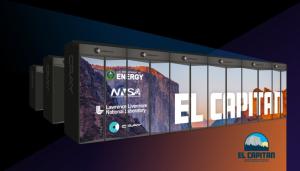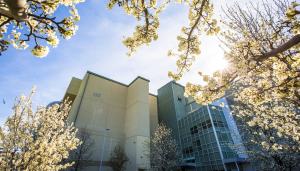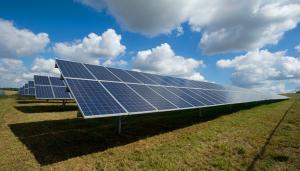LAB REPORT
Science and Technology Making Headlines
Aug. 16, 2019


The Department of Energy, National Nuclear Security Administration and Lawrence Livermore National Laboratory announced the signing of contracts with Cray Inc. to build the NNSA’s first exascale supercomputer, “El Capitan.”
Exascaling El Capitan
Supercomputers are used for everything from mapping weather patterns to developing medicine – now, they're looking after the nation's nuclear stockpile. The U.S. Department of Energy’s National Nuclear Security Administration (NNSA) and Lawrence Livermore this week announced they've signed a contract with Cray Computing for the NNSA's first exascale supercomputer, "El Capitan."
El Capitan's job will be to perform essential functions for the Stockpile Stewardship Program, which supports U.S. national security missions in ensuring the safety, security and effectiveness of the nation's nuclear stockpile in the absence of underground testing. Developed as part of the second phase of the Collaboration of Oak Ridge, Argonne and Livermore (CORAL-2) procurement, the computer will be used to make critical assessments necessary for addressing evolving threats to national security and other issues such as nonproliferation and nuclear counterterrorism.
As you can imagine, that's an enormous and multi-layered remit, which is why they need such a massive computer. El Capitan will have a peak performance of more than 1.5 exaflops -- which is 1.5 quintillion calculations per second. It'll run applications 50 times faster than Lawrence Livermore‘s Sequoia system and 10 times faster than its Sierra system, which is the world's second most powerful super computer, behind Oak Ridge's Summit. It'll be four times more energy efficient than Sierra, too.

In the National Ignition Facility’s 10 years of operation, more than 2,700 experiments have helped to ensure the current and future nuclear stockpile is safe, secure and effective, whie the last has made significant progress toward fusion ignition, and yielded new insights about the stars and the universe.
You say it's your birthday
In the decade since Lawrence Livermore’s National Ignition Facility (NIF) began operations, NIF has routinely heated and compressed matter to some of the most extreme temperatures and pressures ever obtained on Earth – temperatures of 100 million degrees and pressures 100 billion times that of the Earth’s atmosphere.
Funded by the Department of Energy’s National Nuclear Security Administration (NNSA) as a key component of the Stockpile Stewardship Program, NIF is the world’s largest and most energetic laser, designed to allow unprecedented experimental access to the physics of nuclear weapons and help undertake the grand challenge of maintaining the U.S. nuclear deterrent without further underground testing. This knowledge helps ensure the current and future nuclear stockpile is safe, secure and effective, and helps scientists better understand the behavior of matter throughout the universe.
“NIF’s completion represented critical and tangible proof of America’s commitment to modernizing and recapitalizing our nuclear enterprise,” said NNSA Administrator Lisa E. Gordon-Hagerty. “The research conducted at NIF is invaluable in establishing the effectiveness and credibility of America’s nuclear capabilities.”
“NIF stands as a shining example of what NNSA seeks to accomplish in terms of both infrastructure investment and scientific achievement and demonstrates the U.S. commitment to remaining the world’s leader in high energy density science,” Gordon-Hagerty added.

Microbial Tracking-2 hardware aboard the International Space Station, where it collects samples of the microbes and viruses floating in the air. Image courtesy of NASA.
Making waves on the space station
Each year, the president of the United States selects an elite group of scientists and engineers at the beginning of their independent research careers to receive the Presidential Early Career Award for Scientists and Engineers. This is the highest honor given by the U.S. government to outstanding science, technology, engineering and mathematics (STEM) professionals at this point in their professions.
David Smith from NASA is one of this year's winners. He plays a role on a team with Crystal Jaing , a researcher from Lawrence Livermore National Laboratory, that is investigating microbiology on the space station in a project called Microbial Tracking-2. “Our goal is to identify any correlations of the microbiome community between what is in the space station versus what’s on the astronauts to see if there is any microbial transfer and the potential impacts to crew health,” Jaing said.
While Smith’s previous research was based within our atmosphere, he shared an interest with Jaing in detecting microorganisms in challenging environments. “My work in graduate school was finding microbial signals in the upper atmosphere,” Smith said. “When Crystal put together this proposal, we knew that some of those microbes would also be floating around in spacecraft air. We thought we would bring some of the methodology from the open atmosphere here on Earth to the station.”


New research by LLNL scientists shows that solar cell efficiency can improve by using metal nanowire meshes that provide high transmissivity and high electrical connectivity. Image by Creative Commons.
ArRays to improve solar cells
Transparent electrodes are a critical component of solar cells and electronic displays. To collect electricity in a solar cell or inject electricity for a display, you need a conductive contact, like a metal, but you also need to be able to let light in (for solar cells) or out (for displays).
Metal is opaque, so the current techniques use metal oxides, most often indium tin oxide — a near-critical rare earth metal — as the conductive contact. Because supplies of this rare earth metal are limited, Lawrence Livermore National Laboratory researchers have turned to ordered metal nanowire meshes that provide high transmissivity (due to the small diameters of the nanowires), high electrical connectivity (due to the many contact points in the mesh) and use more common elements.
For transparent electrode applications, having such small metal nanowire meshes is important because their small nanometer-size diameter enables more light to pass through while the ordered nature of the arrays/meshes increases the number of electrical contacts between nanowires, increasing conductivity.


A woman cools off in a water fountain in Marseille as a heat wave hit much of the country last month. Photo by Jean-Paul Pelissier/Reuters,
Getting warmer
The heat wave that smashed temperature records in Western Europe last month was made more intense by man-made climate change, according to a recent study.
The study by a respected team of European scientists points to an array of evidence that man-made global warming was behind the continent's most recent heat wave. "The July 2019 heat wave was so extreme over continental Western Europe that the observed magnitudes would have been extremely unlikely without climate change," the study concluded.
An expert not connected to the study, Celine Bonfils of the Lawrence Livermore National Laboratory, said the findings are clear: "record hot weather events are becoming more likely, and human-induced climate change is causing this increase in heat wave frequency."
The new report agreed with her assessment, saying that every recent European heat wave that has been analyzed "was found to be made much more likely and more intense due to human-induced climate change."





